Catania reveals from the monuments and from archaeological excavations all the dominations and populations that have crossed and inhabited it, enriching it in traditions and monuments. Among the populations who fell in love with this area and this landscape that ranges from the Ionian Sea to Etna, there were the Romans.
Of the monumental ruins of the Roman era there are still clearly visible traces, surviving the centuries and eruptions, sometimes embedded in the lava rock, incorporated between modern buildings or prisoners of private alleys and courtyards, or still unexplored in the subsoil of today's city.
Ready for a trip back in time? In this guide, we will go around Catania in search of traces of the glorious Roman civilization.
Before starting our tour and putting ourselves in the shoes of skilled urban archaeologists, it is good to know a bit of history. The Romans conquered Catania in 263 B.C, at the very beginning of the First Punic War. The protagonist of this epic enterprise was the consul Massimo Valerio Messalla.
Around 135 B.C, Catania was the scene of revolts due to the first servile war and in 35 B.C of the revolt led by the gladiator Seleuro. Starting from 122 B.C the territory was severely damaged by the volcanic activity of Etna including the disastrous lava flow of 32 B.C . To The decline due to natural catastrophes was added the conflict between Octaviano and Sesto Pompeo which devastated Sicily. From 21 B.C, elevated to the rank of colony by Augustus, the city was heading towards economic recovery.
Although, due to the importance and strategic position of the city, the spread of the Christian cult can be immediately hypothesized, historical research confirms the presence of Christian communities in Catania starting from the III century. Among the testimonies there are the martyrdom of Sant'Agata, patron saint of the City, which occurred during the persecution of Decius (250-251) and the martyrdom of Sant 'Euplio during the persecutions of Diocletian (303-304). Furthermore, in an epigraph, from the III-IV century, the news of a "martyrium with early Christian tricora basilica" is handed down. Even with regard to the episcopal seat, there is certain information only between the fourth and sixth centuries; tradition, however, indicates that Beryl of Antioch was the first bishop sent by the apostle Peter to evangelize Catania in 42 A.C . The Roman domination ended in 440 A.C., with the conquest of the island by the vandal Genserico.
The city plan of Roman Catania was set on two orthogonal axes, the cardo and the decumanus, around which the public buildings stood.
The Amenano river, now underground, flowed into the city, and an aqueduct erected by the Romans conveyed the waters coming from a distant source.
To find the traces of a thermal complex, head from the B& B Palazzo Speciale towards Piazza Currò to admire what remains of the Terme dell ‘Indirizzo, which belong to the Greek-Roman Archaeological Park of Catania. The site you are aboout to visit is free, but open by reservation. To book, write to poloregionalect.urp@regione.sicilia.it, or call 095 7150508.
The baths take their name from the nearby Church of the Madonna dell'Indirizzo. Today, of the original complex, remain ten rooms that keep the roofs with barrel, cross and dome vaults almost intact; among these, the octagonal room which served as a calidarium is interesting.
was fed by the Amenano river. Then continue along our path to find the ancient and, apparently, disappeared river. A few meters away , from where we are, next to the staircase leading to the Pescheria, the south side of Piazza Duomo opens up, and - right here - you can admire the Amenano Fountain, animated by the legendary waters you went in search of. The Carrara marble statue, by Tito Angelini, is the representation of the River: a young man holding the cornucopia in his hand.
Take a coin, express the desire to go back in time, to the Roman era and, keeping your eyes closed, throw it into the fountain, thus entrusting your dreams to the flow of the Amenano in the underground city.
After this propitiatory rite, as magical as it is romantic, you are really ready to start the tour suggested by the
and, thus, dive into the past by visiting the Achillian Baths that branch off under the Cathedral; even today, their real extension is not known, as only a small part of the original plant can be visited.
Built around the third or fourth century, we know the name of this place thanks to an inscription from the fifth century d.C. (preserved in the Castello Ursino Civic Museum) and to the documents of Bishop San Leone from the eighth century; it is assumed that the name "Achilliane" is due to the name of the builder, or to a lost statue of the Homeric hero.
If today the baths are accessible- after being buried by the known natural disasters that occurred in the 17th century-we owe this first of all to the Prince of Biscari, Ignazio Paternò Castello, who freed it from debris in the 18th century.
Then head to the Cathedral , the ticket office is waiting for you in via Etnea 8. The visits take place from Monday to Friday, from 9.00 to 14.00; Saturday from 9.00 to 13.00; on Tuesdays and Thursdays access is also allowed in the afternoon, from 3.00 pm to 6.00 pm; On Sundays and holidays, however, the site can only be visited by reservation and for groups of at least 20 people. Keep in mind that the last admission to the
is allowed half an hour before closing. The ticket for the thermal baths only has a cost of 5 Euros; however, we recommend that you buy the Cataniapass, a tourist card that allows access to municipal museums, the Diocesan Museum, the Achillian Baths and the use of urban public transport, including Alibus and the subway.
The Achillian Baths are accessed via a corridor covered by a barrel vault in cement mortar, supported by walls made up of blocks of lava stone ending in a double row of bricks. From this corridor, other rooms connected, including the tepidarium, of which today the curvilinear hall and the canalization system can be observed. Going along the corridor it leads to the central hall, which can be visited, with a rectangular plan with four pillars on which the vaults are set, decorated with stuccos depicting branches and bunches of grapes. At the center of the "pillared room" is the basin which was originally covered in marble, as well as the flooring of the room, probably in opus sectile.
Stay on Piazza Duomo for now and head towards Sant'Agata’s Cathedral; in its façade you can see columns, probably removed from the Roman Theater of Catania.
Go inside now to admire the wonders of sacred art; towards the right aisle you can see the Chapel of Sant'Agata, where the bust and the casket are kept that contain the relics of the holy virgin, patroness of Catania, martyred at the time of the Roman Emperor Decius (249-251 d.C.) by the hand of the cruel proconsul Quinziano
Roman floor in Palazzo Biscari
Palazzo Biscari is located Near Piazza Duomo in via Museo Biscari, still partly inhabited by the noble Moncada Paternò Castello family.
The sumptuous palace can be visited every day, but it is always better to make a reservation by calling the number 095 7152508. The cost of the ticket is around 10 euros.
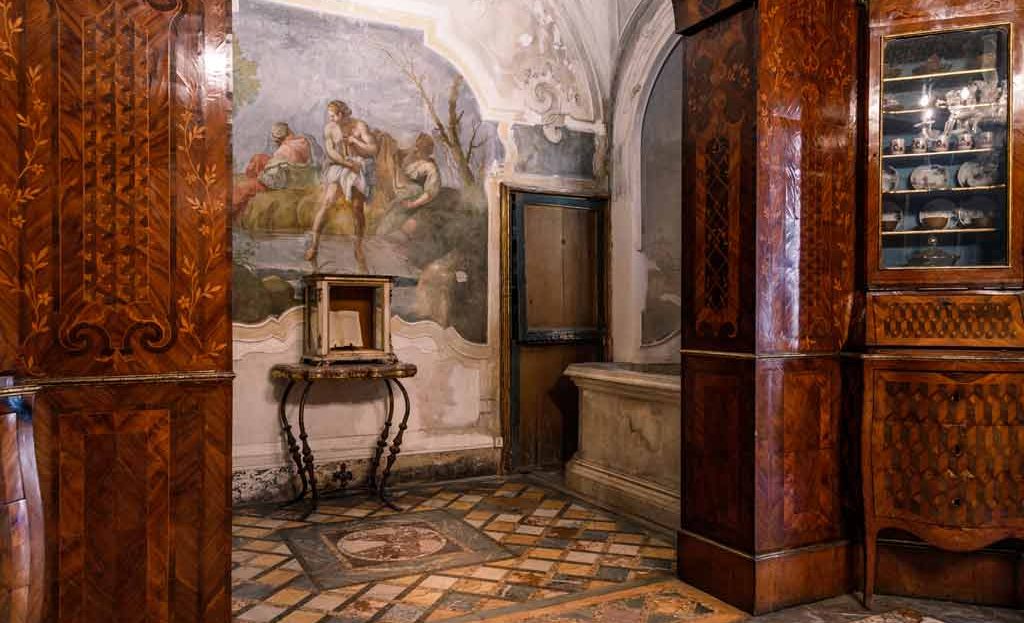
In addition to the decorations, the architectural and artistic wonders, remember that you are going to walk on a real Roman floor in colored marbles that Ignazio Paternò Castello, 5th Prince of Biscari, in the 18th century, as a passionate researcher of antiquities, found and used to decorate the "apartments of the princess".
Necropolis of Catania
Palazzo Biscari is wonderful, isn't it? We think so too; now, find and walk via Etnea to Villa Bellini; once here, turn into Viale Regina Margherita and follow it up to number 35 where the nineteenth-century Villa Modica is located, in whose garden there is a Roman patrician tomb.
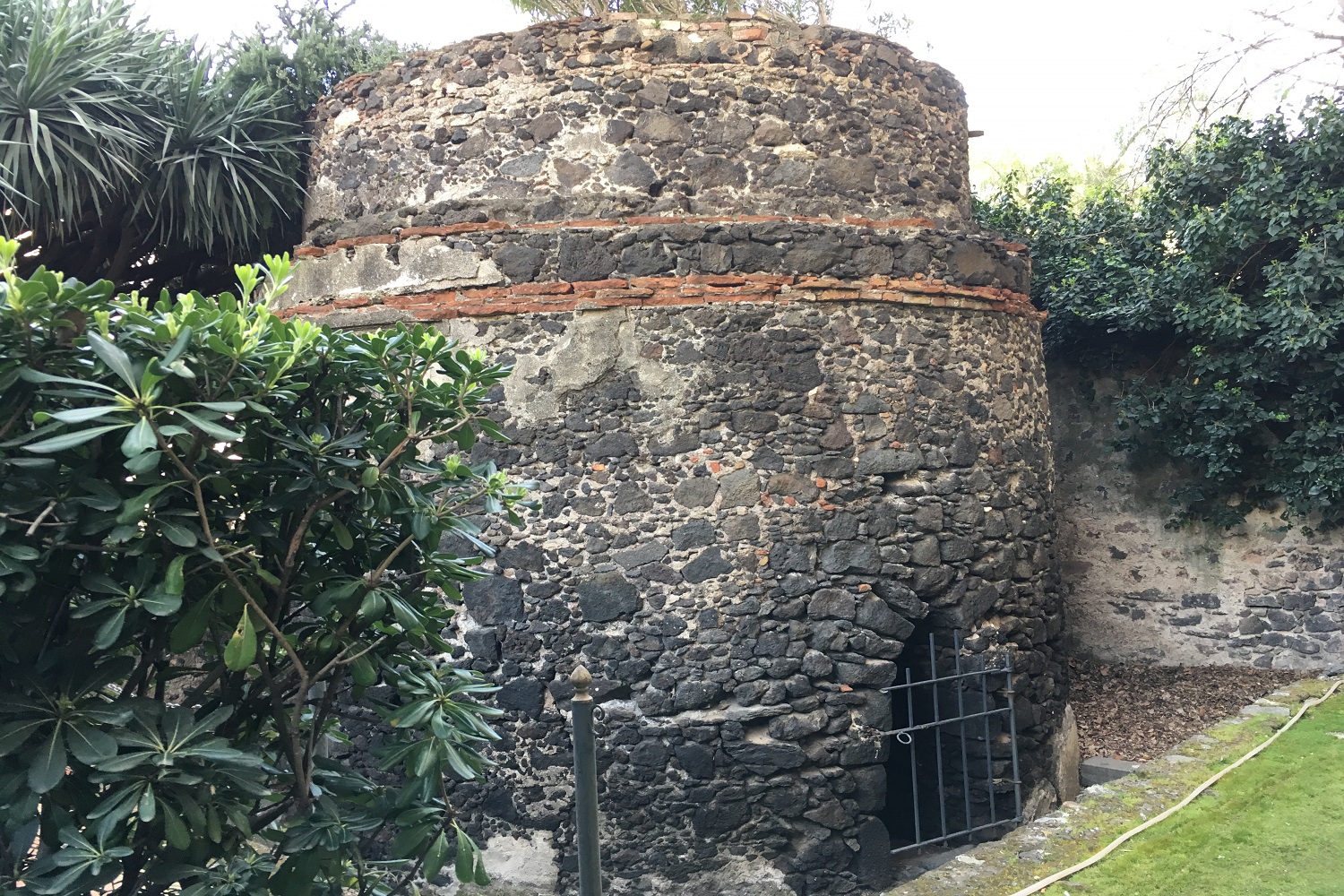
The mausoleum, with a circular plan with a diameter of almost 8 meters, is accessible from an arched opening which, once crossed, allows you to admire the walls on which niches are carved. The area is private, but the owners allow the visit which, however, should be agreed.
If you can't visit the circular mausoleum, don't worry, because a few meters from this place, there is a square hypogeum of which you can admire the large rectangular structure.
The visit is free, but by reservation; to book, write to poloregionalect.urp@regione.sicilia.it, or call 095 7150508.
"The eastern half of the building is made up of a massive body , while the opposite half is occupied by a square room, originally vaulted, accessible via a staircase". In the back wall there is a rectangular niche, while four other niches are found on the other walls.
After visiting the square Hypogeum, resume your journey towards Piazza Santa Maria di Gesù, to admire an PaleoChristian tomb located in the Church of Santa Maria della Mecca, known today as the Chapel of the Garibaldi Hospital; this small church, in fact, is located inside the courtyard of the Giuseppe Garibaldi hospital in Catania.
At the end of the visit, retrace your steps, and retrace the viale Regina Margherita until you meet via Sant'Euplio where the ruins of a church dedicated to the patron saint co-patron of Catania are located.
The church was destroyed by an air raid in 1943, but a staircase leads to an underground room, carved into the rock, with side niches, where, according to legend, the saint was captured to be martyred.
This place is often closed but you can book a visit through the
Etna'ngeniousa association by calling 338.1441760 or by writing to the e-mail address
asso.etnangeniousa@gmail.com.
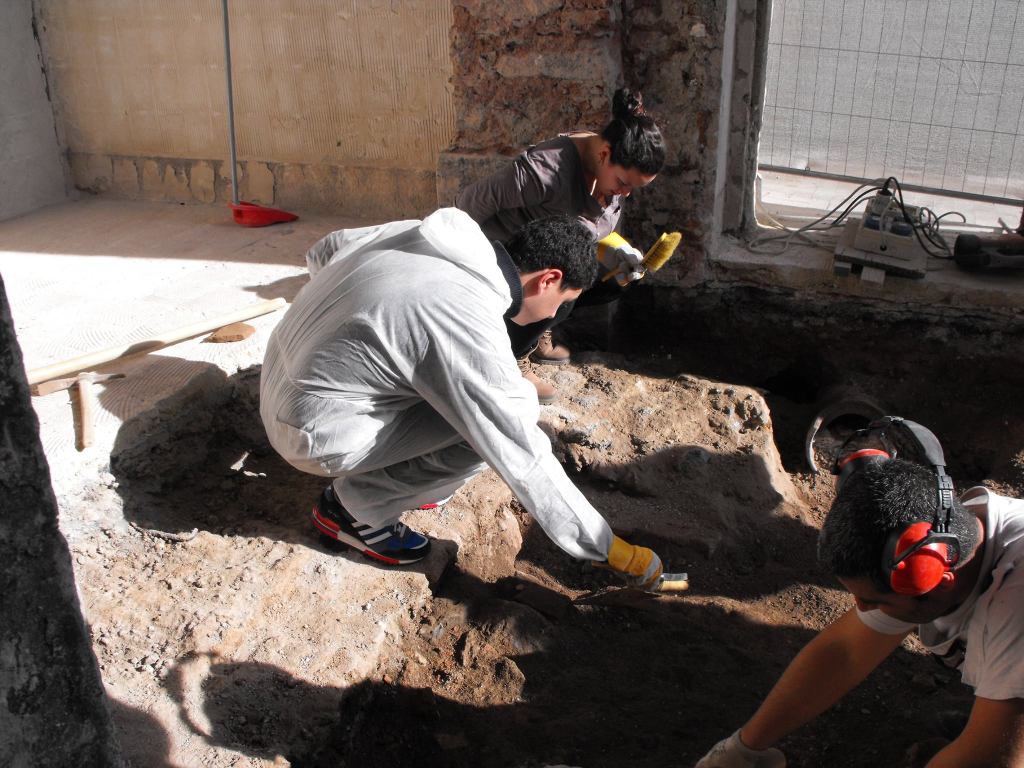
After this visit, head towards Piazza Carlo Alberto, where in one of the inner courtyards of the former Convento del Carmine, now the Army Documentary Center, you can partially glimpse another Roman tomb; built in blocks of lava stone, it is said to have been the first burial of Sant'Agata even if someone, on the other hand, identified it with the tomb of the poet Stesicoro.
Also in Piazza Carlo Alberto, if you are lucky enough to find it open, you can visit the Church of San Gaetano alle Grotte which houses a Roman crypt from the 3rd century d.C.
The Roman amphitheater
Once the research on the Roman necropolis is finished, continue along via Etnea until Piazza Stesicoro where you will meet the Amphitheater of Catania, or rather, the largest and most complex of Roman amphitheaters in Sicily. Observing the area from the square, the large inscription "Per me civitas catanensium sublimatur a Christo" immediately stands out, phrase attributed to Saint Agatha.
Built around the second century, since the Middle Ages it served as a quarry to recover material useful for the construction of buildings; in 1693 it was buried by earthquake disasters, only to be finally brought back to light in the early twentieth century.
The amphitheater can be visited from Tuesday to Saturday, morning and afternoon; to enter and begin your visit, you just have to go past the Doric and Ionic columns which form the jambs of the metal door decorated with the architrave on which, as if to welcome you, the inscription «Amphitheatrum insigne» stands out.
Among the alleys, further discoveries.
After the visit inside the site, you will be asking yourself three questions: why inside the amphitheater, on the walls there is an inscription bearing a sentence attributed to S. Agata? how high was the Amphitheater? how far did the Amphitheater extend?
To answer the first question you just have to visit two churches: San Biagio and Sant'Agata al Carcere; the reason simple: the martyrdom of the Saint took place in this area of Catania. The Church of San Biagio, in fact, is located in Piazza Stesicoro, right in front of the Amphitheater and is also known as Sant'Agata alla Fornace; according to tradition, it is in this place where the furnace , which remains are preserved in a reliquary above the altar was found and with which the holy co-patron of the city was mortally tortured.
The Acts of martyrdom tell not only that Agata was subjected to increasingly cruel oppression until she died on February 5, 251 d.C., but that, with each new martyrdom, she was locked up in prison. The prison where the holy Roman virgin was locked up and then expired is located just a few meters from us: today's Church of Sant'agata al Carcere; to reach the holy place, take via Cappuccini which is to the right of the Church of San Biagio, keep to the left side, and you will arrive at the destination, Piazza Santo Carcere.
Inside the Church, on the right of the presbytery, there is the small access door to what tradition identifies as the Prison of Sant'Agata; on the right wall of the presbytery, however, it is possible to observe - always according to tradition - the footprints of the saint left imprinted on the lava stone slabs.
Now, however, it is time to know how tall and extensive the Roman Amphitheater was; to find the answer to your questions, you have to leave the church and take that downhill road that opens in front of you, via del Colosseo, and which leads to via Manzoni. Take the street, head right where you will immediately encounter a sign indicating Vico Anfiteatro; inside, you can see three large arches that support the wall of the hanging garden of Villa Cerami, which provide the height of the Amphitheater.
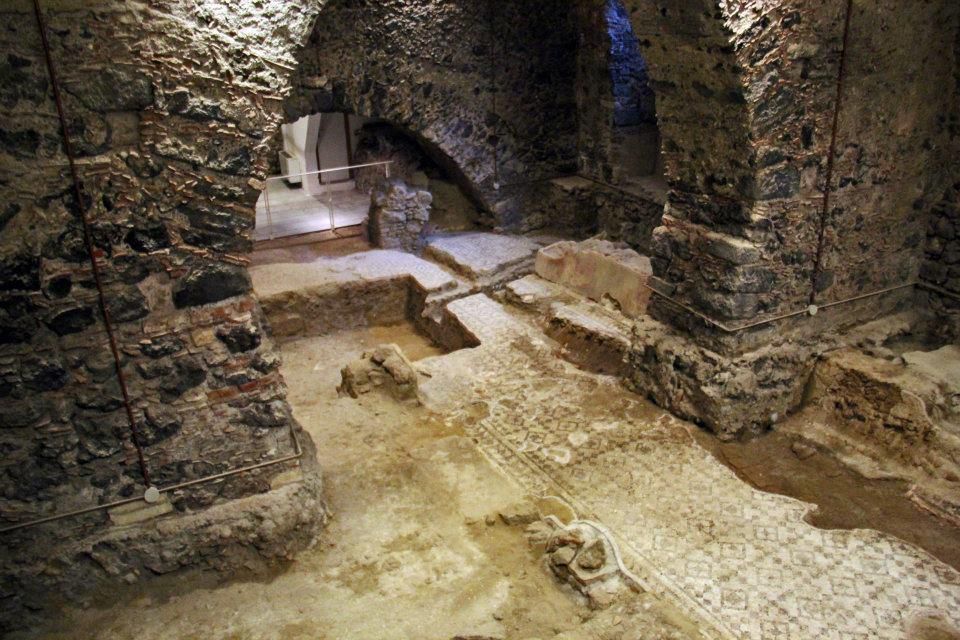
Head again along via Manzoni, take via Penninello and follow it up to the steps that lead to via Crociferi; here, it is better to stop and visit the Benedictine Monastery where it is possible to admire the remains of a Roman domus. Three rooms can be recognized from the remains: a courtyard with slabs of basalt stone, a pantry with the remains of a washbasin and a space oriented towards via Crociferi.
Once the visit to the Benedictine Monastery is over, from via Crociferi turn into via Cerami where the seat of the Faculty of Law, Villa Cerami is located. Right here-inside the Villa Cerami-by observing part of the arch system that connected the Amphitheater to the hill, you can realize the extent of the Amphitheater
Roman Prison
Now, from the Faculty of Law, go to via San Giuliano; here, next to the Church of the Minoritelli, right in front of the Santa Marta hospital, you can admire the remains of a Roman prison where, according to tradition, the saints Alfio, Filadelfo and Cirino passed through before their martyrdom
Balneum di Piazza Dante, Monastero dei Benedettini
Keep going up to via San Giuliano, until you reach Piazza Dante where the former Benedictine Monastery stands, today is the seat of the Faculty of Letters and Philosophy. In front of the monastery, protected by an iron gate, it is possible to admire the remains of a small thermal plant, and more precisely the balneum of a domus.
Crossing the entrance into the courtyard of the University, it is possible to observe a part of the Roman road, the cardo.
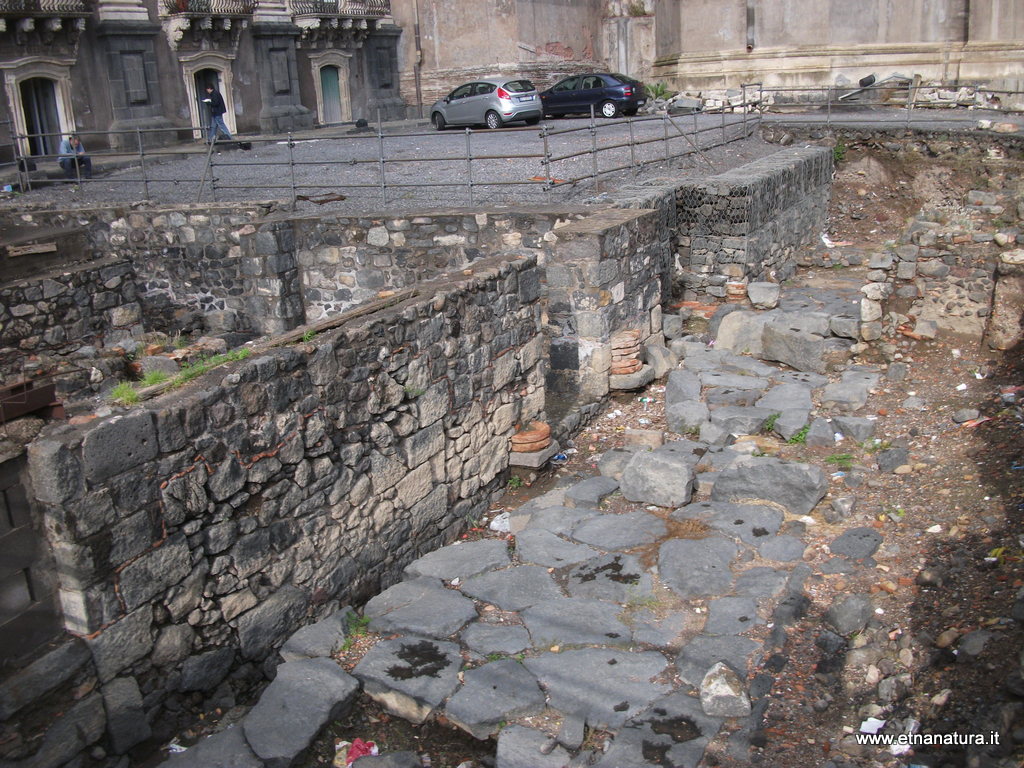
The monastery is a jewel of magnificence that hides many wonders; inside - in the University newspaper library - it is possible to admire the mosaics of a Roman domus.
To visit the monastery you can take advantage of the guided tour, organized by the
Cultural Workshops association which takes place every day from 9.00 to 17.00, at a cost of about 8 euros.
Terme della Rotonda
After visiting the former Benedictine Monastery, walk along via dei Gesuiti until you reach on the right via Marino which will take you to our destination in via della Mecca: the monumental Complesso della Rotonda. The visit is free, but open by reservation; to book, write to poloregionalect.urp@regione.sicilia.it, or call 095 7150508.
In this area, which already presented evidence of the Copper and Greek Ages, in the 1st or 2nd century d.C., a thermal structure was built in Roman times, which functioned until the 6th century and then became a church of probable Byzantine origin.
The spa complex consists of nine rooms, once paved with mosaic or marble and frescoed walls, arranged to the South and East of the large circular room known as the "Rotonda" which, due to the presence of numerous pools, would seem to have been a calidarium or a nymphaeum. North of the Rotonda, there is a large cistern which, connected to the ancient aqueduct, fed the thermal complex and which is connected to the Rotonda through a square-shaped room.
Roman Forum and Balneum of Piazza Sant'Antonio
Near the Roman theater, from via Vittorio Emanuele take via Politi and then turn into via Orfanelli, the road that leads to the Cortile di San Pantaleone, where you can admire the remains of the Roman Forum: a couple of rooms and a wall in opus reticulatum. The
Roman Forum of Catania, according to tradition, is the place where Sant'Euplio, co-patron of the city, was martyred.
From the courtyard of San Pantaleone, reach the via SS. Trinità up to via Sapuppo, then turn into Piazza Sant'Antonio; in this square there is a
balneum of which you could glimpse the frigidarium unfortunately an iron and glass structure, to protect the ruins, prevents its use.
Antiquarium, Roman Theater, Odeon
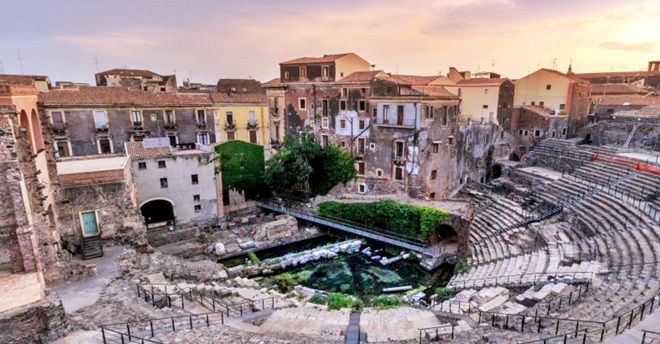
Now direct your steps at the Ancient Theater of Catania. The site is accessed from via Vittorio Emanuele 266; rarely, it can be accessed from another entrance in via Teatro Greco 47.
Remember that this site is open from 9.00 to 19.00; if you have decided not to buy the Cataniapass, the single ticket costs from 3 to 6 euros.
Before entering the theater, it is necessary to visit
Casa Pandolfo and
Casa Liberti, today the headquarters of the regional
Antiquarium of the Roman theater, where some important archaeological discoveries found in the city are exhibited.
The Roman theater dates back to the 2nd century and was built on a Greek theater; today the orchestra, the cavea and parts of the stage building remain visible; as you can see once you enter, the cavea is only partially preserved; in fact, the upper tiers have been lost.
To the west of the theater is the
Odeon, a small theater also dated around the second century, whose cavea - it is assumed - could hold 1,500 spectators; probably, the monolithic aspect of the building, due to the lava stone, was instead endowed with marble decoration, as the orchestra also attests.
Castello Ursino and Piazza Mazzini
Now, you just have to visit the Castello Ursino Civic Museum. From Piazza Sant'Antonio proceed along Via Sapuppo, then turn right into Via Santa Maria dell'Aiuto until you reach Via Naumachia on the left; from here, turn first into via Santa Chiara, then onto via Riccardo da Lentini until you reach via Castello Ursino; follow this road to Piazza Federico di Svevia, where the Frederick Ursino Castle stands, which houses the Museum.
The Castle - which for its history, deserves a visit even without the museum collections - is open every day, from 9.00 to 18.00. The collections of the Museum are many and vast; among the many exhibits and works of art there is a vast collection of archaeological finds dating back to the Hellenistic and Roman times.
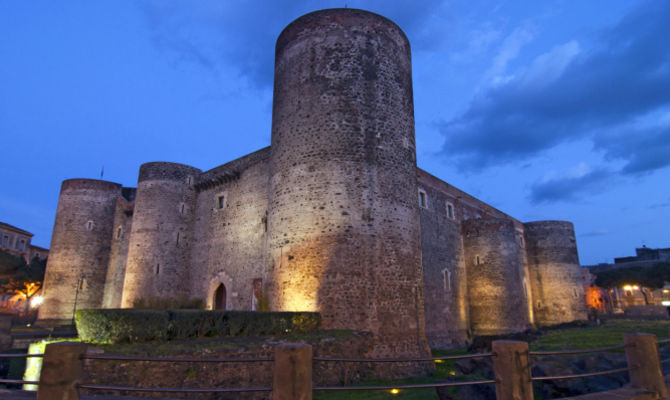
After the visit, at the Ursino Castle resume Piazza Federico di Svevia, take via Auteri and follow it until you meet, on the left, via Giuseppe Garibaldi until you reach Piazza Mazzini where, between the arcades, you can observe eight columns from the Roman period, perhaps once belonging to a basilica that has now disappeared.
The Amenano grotto
After the discovery of the Roman finds in the historic center of Catania, you have understood that many remains of the ancient city are still hidden today under the urban soil, but it is now time for dinner, and perhaps it would be appropriate to finish where you started this tour: the Amenano river.

And here you are at your last stop
: A putia dell'Ostello in Piazza Currò where you can treat yourself to an ecstatic moment with the flavors of Sicilian cuisine in a lava cave crossed by the waters of the legendary River. To be sure to get a table right on the banks of Amenano it is necessary to book at +39 095 723 3010.
Remember
Useful numbers to book the visits recommended in this guide:
- Terme dell ‘Indirizzo, Square Hypogeum, Monumental Complesso della Rotonda
Tel: 0957150508
e-mail:
poloregionalect.urp@regione.sicilia.it
-Palazzo Biscari
Tel:095 7152508
- Monastero dei Benedettini by the Associazione Officine CulturaliTel: 095 7102767 | 334 9242464e-mail:
info@officineculturali.net;
- Crypt of Sant'Euplio by the
Etna'ngeniousa Association
Tel: 338.1441760e-mail:
asso.etnangeniousa@gmail.com.
- A putia dell’Ostello
Tel: +39 095 723 3010